Lesson Four - Accessories and Other Equipment Options
A variety of accessories are used along with the attachments covered in the last lesson. They are used to fell the log, move the logs into position and attach the log to the cable. They allow the log to slide easier and skid forward at an angle if necessary. These items are described below in the order that you would use them when felling and skidding the tree.
Lesson Four also looks briefly at options other than an ATV or tractor as your main machine. Some of these options are not commonly used but may suit your situation.
ACCESSORIES
Chain Saws
| For homeowner use: | Small saw 40 cc and under |
| For woodlot work: | Intermediate saw 40 to 60 cc |
- Get one that is big enough for the tree size and cut size you plan to do.
- Newer ones have fewer emissions.
- Talk to chainsaw owners as well as a few dealers.
- If possible, take a saw home for the day to try out.
- Choose a reputable dealer who is not too far away when you need repairs.
- Check the Internet for chainsaw options and to chat with other users.
- Complete a training course before you start to cut.
To sum up, do your research so you don’t buy a saw that is not up to the job. To learn more about chain saws and felling tools, read Module Six - Chain Saw Use and Safety.
Felling levers
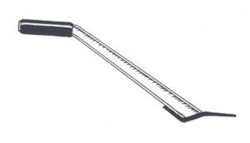 |
| 4.1 Felling lever |
First notch the tree low to the ground on the side you want it to fall. Then do a cut on the other side. You can insert a felling lever there part way through the cut. This keeps the saw from getting jammed and helps you push the tree over. The lever can also be used to roll trees that hang up when skidding. Another innovative tool is a felling jack made with a car jack in the middle of two square tubes and a wedge on either end.
See Module Six, Chain Saw Use and Safety which includes a lesson on safe felling and felling tools.
Cones, pans and grapples
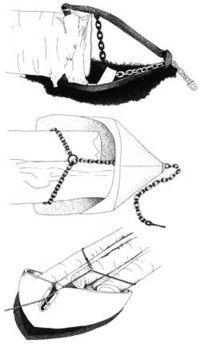 |
| 4.2 Grapple, cone and pan |
Using these accessories allows the log to slide easier and reduces hang-ups on obstacles while winching and pulling. Which one you use depends on the size of the logs and how many logs you are winching at once. If you are winching one log, a grapple can be used. For one or more, a cone can be used. A pan can be used for two or more small logs. If using a cone or a pan, pre-bunch the logs for pick up and use a choker to hold the log(s) in place.
Cables (Steel verus Synthetic)
Steel cable has been a standard for many years because it is strong, durable and low cost. A synthetic cable Kevlar® was also used. More recently a synthetic fibre called Spectra®, already common in other industries, is now being used in forestry.
Spectra® cable allows for longer winching distances which means less trails and less impact on the soil. It is eight times lighter than steel so there is less work for the operator to haul out and handle. It is also easier on the hands than steel. ( Note: This information refers to 12- strand double-braided hollow core Spectra®)
The cable should be pre-stretched by winching a few light loads with no sudden jolts. Inspect the cable regularly for abrasion and cutting. Reverse the cable from time to time to ensure even wearing. Also recoating the cable helps it resist dirt.
See the FERIC guide, Spectra Rope for Skidder Mainlines.
Chokers
If using a tractor and /or a powered winch, chokers (made of chains or cables) are used to attach the logs to the mainline. Chokers are useful for gathering logs that are spread out. They are at least 2m (6 ft) long with a 20cm (8 in) rod on one end and a ring or hook on the other. The rod is used like a needle to pass the choker under the log and back through the ring. See “How to use a choker” in the next lesson on winching.
Snatch blocks
Snatch blocks (or pulleys) are very useful for winching around obstacles and at an angle. (see Lesson Five under Winching Techniques). Some are manual release and other more expensive ones are self release. They are attached to the tree with a chain or strap (use a strap if saving the tree since a chain will damage it).
Self releasing snatch blocks drop the load once it reaches the tree to which the block is attached. For a manual one, you use a pin. These blocks can also be used when moving a stand-alone winch to where you want it or freeing a hung-up log that you are skidding.
Tongs and hooks
These are used to help lift the log into position for skidding, forwarding or if it gets stuck. Tongs have two points and allow you to grab and lift a log with one hand. A hook has one point and is jabbed into the log to lift it. These tools really save your back.
OTHER EQUIPMENT OPTIONS
Stand-alone winches
Yankee Yarder
Skidding Distance - Up to 75 m
The Yankee Yarder is a full time winching platform on a sled. It is designed to be a self-propelling unit. The cable is spooled off the winch drum and pulled out to where you want to work from and attached to a tree. You then start the winch and the Yankee Yarder pulls itself to that tree. The process is repeated until you get to where you want to be. It can also be hauled by an ATV, in the back of a truck, pulled on a trailer hitch or moved around manually like a wheel barrow. It runs off a small gas engine (5- 10 HP).
Cost: $1,500
Chain saw winch
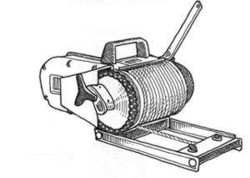 |
| 4.3 Chainsaw winch |
The chain saw winch is a smaller and lighter than the Yankee Yarder and runs off a chainsaw engine. It is generally meant for emergency or part time use. Models vary in size and pulling capacities from 900 kg (1,980 lbs) up to 3600 kg (8,000).
Cost $1,200
These winches usually need snatch blocks for getting around trees and winching at an angle. See Appendix B for Web sites.
Mini-Skidders
A mini-skidder, also called a walk behind, is a tracked machine that the operator walks in front of. It is gas powered with a boom, winch and cradle and can pull a small trailer. These work well but are slow and relatively expensive at $10,000. They are not very versatile so are not common but may be a solution if you do not own or need a tractor or ATV and want the winching/hauling capability. See Appendix B for Web site.
Skidders
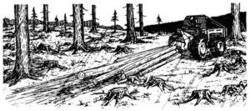 |
| 4.4 Skidder |
If you are harvesting or plan to harvest very large amounts of wood (100 plus cords/362.5 m³) per year), you may decide to invest in a skidder. This is a powerful, tractor-like machine that comes is various sizes and is designed specifically for skidding wood and so is not as versatile as an ATV or tractor. It is much more expensive than a tractor but it can manoeuver easily in open conditions and move more wood in a given time.
A skidder may be a cost-effective option in that it is purpose built and does not require additional expenses to provide the necessary protective structures to operator and machine.
Off-road Utility Vehicle
An off-road utility vehicle (UV) is similar to an ATV but with some important differences. It is wider and longer and two people can sit side by side. This makes it more stable in the woods but most models are not as maneuverable. It can also be more powerful than most ATVs . They can be a 2x4, a 4x 4, or a 6 x6 wheeler.
The UV has a larger storage area in the back called a cargo bed where a small amount of short wood can be piled. It usually has ROPS. Some can be outfitted with a track kit as can ATVs ( like a snowmobile) that helps in deep snow and mud. It costs more than an ATV but the extra versatility may make the investment worthwhile depending on your needs.
Snowmobile
A snowmobile can be used for skidding or forwarding wood. For woods work, you want a utility snowmobile not one designed for touring on groomed trails. The track on the machine should be at least .45 m (16 in) wide, and a long track of 3.8 m (11.3 ft) is preferred to distribute the weight.
An engine size of 500-550 cc is recommended. Also look for one with low gearing. A snowmobile with an air cooled engine is lighter than a liquid cooled engine and so less likely to get stuck. Another feature to look for is storage under the seat. Utility snowmobiles start at around $8,000.
Longer, wider, more powerful machines can also be used that have better traction, buoyancy and high and low gears. The disadvantages are increased cost (about $11,000) and weight. Also the increased length means that it works better in open situations.
Horses and Oxen
Some woodlot owners in Nova Scotia use horses or oxen for small scale harvesting.
This is done mostly in winter. It requires operator skill and knowledge as well as daily care and attention to the animals. In a selection cut, one horse logger says it is twice as fast as using a tractor and winch, and more profitable in some situations. He also says it can be much less damaging to the forest. It is not efficient for a high production clearcut situation.
Most attachments suitable for ATVs or small tractors can be used with horses or oxen. Cables can be used to skid the wood along with sleds, sulkies, cones, pans and grapples. Loaded trailers can be pulled by the horses or oxen.
Truck Tractor
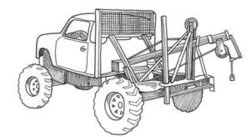 |
| 4.5 A truck tractor has high approach and departure angles. |
A truck tractor is an old truck converted into a tractor-like machine for skidding wood. People who are mechanically talented and have access to a garage may want to consider this option. It requires some modification to the body and time to do the work but it is cheaper than a tractor.
Some keys to good truck tractors:
- High ground clearance (more than nine inches)
- Good wheel contact based on suspension travel
- High approach and departure angles
- Low gearing
- 4 WD and/or positive traction rear end
Case Study Three
Custom Built Truck Tractor
Russ Cushing
Russ Cushing believes in truck power. He says that trucks get used to drive to the store when they have enough power for hauling logs out of the woods. So when he needed to harvest wood, he modified a old truck into a truck tractor. By buying old parts and doing it himself, it was much cheaper than a buying a tractor. And he is still using it 25 years later.
Russ has a long, narrow 17 hectare (40 acres) woodlot with white spruce and mixed wood in Plympton, Digby County. He cuts firewood and sawlogs for his own use and “pulls out the trash to encourage the woodland”. He now cuts only about four cords a year for firewood.
Russ says the truck is a handy vehicle for low impact, small scale selective cutting. “I can go in and cut an individual tree I want for a sawlog.” The woodlot has a road up the middle of it which means he can reach almost any tree.
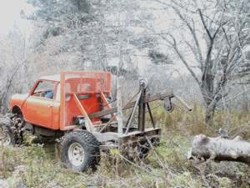 |
| Photo 4.1- Homemade truck tractor |
He began to build his truck tractor in 1981 when ATVs were not readily available . “The idea is you get an old four-wheel drive truck that’s all rusted, take the cab and the box off of it, and then you put a real skinny cab on it like the body off a foreign car.” This allows the door to open easily in narrow trails over the front wheels. He adds that if you use a small extended cab, you can have room for your chain saw and other tools.
Russ shortened a Chevy half ton 4 x 4 and added an Austin mini cab. Besides the usual parts (gas tank, radiator, throttle, cable clutch and steering), he also added a winch and a raisable boom that can telescope.
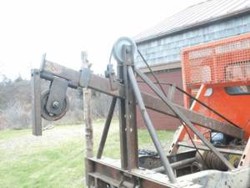 |
| Photo 4.2 - The winch cable can lift the boom up and down |
The winch has four speeds and reverse and a 80 foot cable with a 60 foot booster cable. It is mounted inside the frame over the rear drive shaft The winch is driven by the PTO attached to the transfer case and is used in the neutral position.
The boom can be raised with the winch cable and set at different heights using notches on the arch. It is used for hauling bigger logs and raises the log up higher than the frame. The boom is not used for loading. Russ loads his trailer by hand with smaller logs or chunked up firewood.
The truck has no brakes since his land is fairly flat but the gears can be used to slow down or he can cut the engine with a switch on the dash. He has big tires for better clearance. For a demonstration, Russ hooked up the 15 inch butt end of an unlimbed pasture spruce on rough wet ground. The log bounced easily up and forward as the truck took off through the woods. “Shows you what a regular truck can do” says Russ.
Russ Cushing can be contacted at 902-837-5936 for more information on his truck tractor.
Further reading on accessories and other equipment.....
The Forest Professional, Guidelines for the Stewards of tomorrow’s forests (2001) has a section on Operating Chain Saw Use and Correct Logging Procedures including felling.
For using cables, chokers, snatch blocks, grapples, cones and pans see Using a Farm Tractor To Produce Long-Length Logs or Using an All-Terrain Vehicle To Produce Long-Length Logs.
FERIC has produced a guide called Spectra Rope for Skidder Mainlines that also has information on splicing and attaching the cable.
For more information on skidders, UVs, stand-alone winches and felling tools refer to Small Scale Woodlot Equipment, a binder produced by the Maritime Woodlot Extension Committee.
See Appendix A and B.